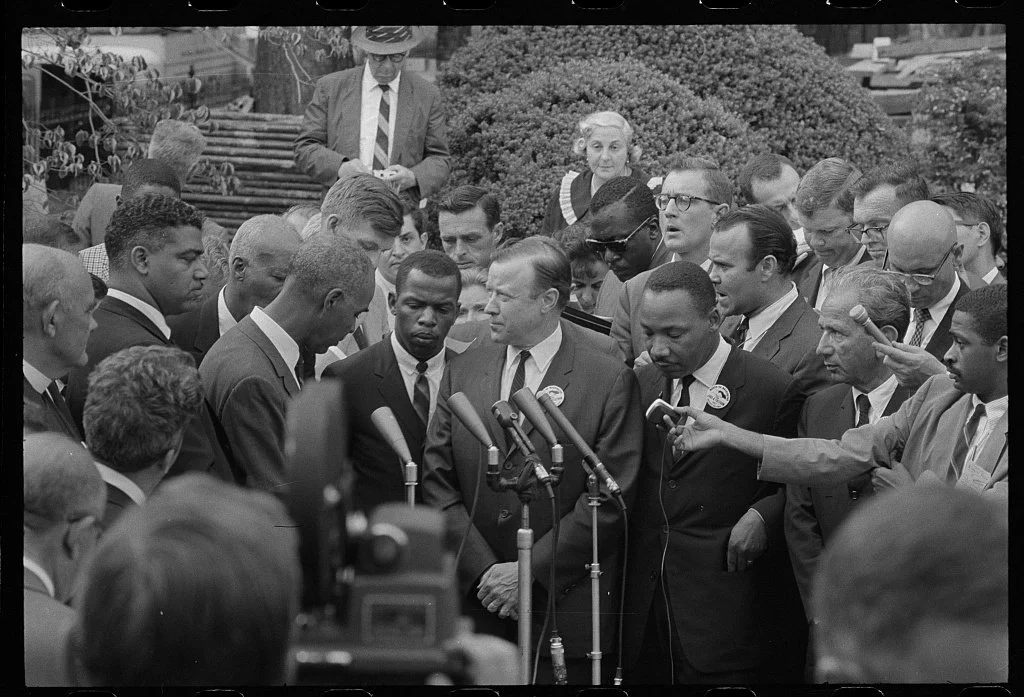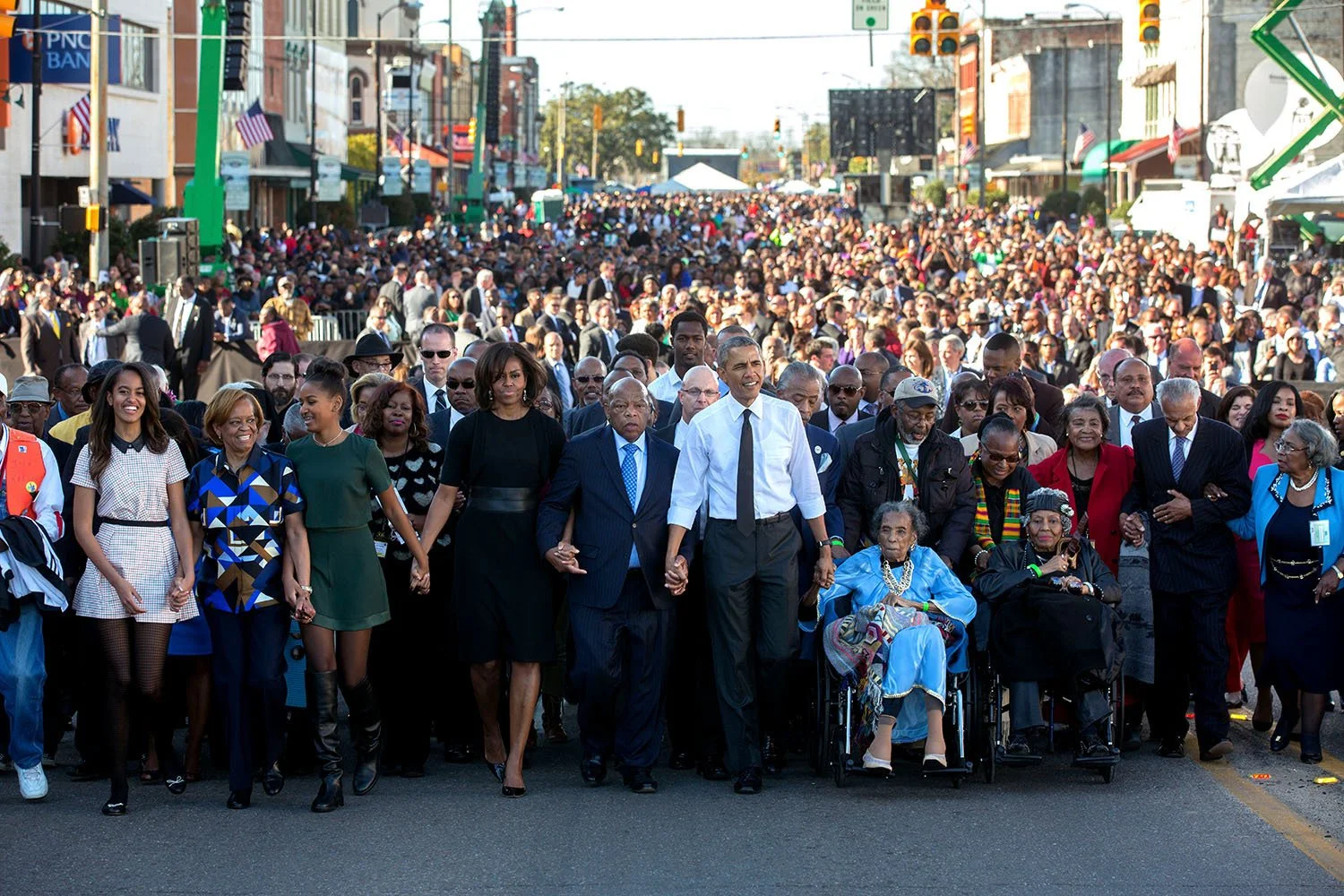Stand Up, Speak Up, Speak Out: Remembering the Legacy of John Lewis
In the 1910s and 1920s, Americans advocated for eugenics as a science, arguing that many of society’s ills could be blamed by hereditary factors (such as race) that made certain people more “unfit” for polite society. This belief system grew in large part out of a desire to rationalize the continued mistreatment of people of color—such as freedmen following the aftermath of Reconstruction. When Nazi Germany took the American eugenics movement and drove it towards its horrifying conclusion, American eugenics took more insidious forms, such as segregation and Jim Crow. For example, the U.S. army during WWII was heavily segregated, with only 10 (out of 91) divisions having integrated combat companies. The military had decided that black people were not fit for combat or leadership positions, and they were mostly relegated to labor and service units. Many black infantrymen were commanded by white officers from the American South, who allowed others to treat them effectively as slaves and animals. Despite distinguishing themselves time and time again, these segregation policies held strong—so strong that even German prisoners of war were allowed into facilities that American black servicemen could not enter. After the war, black soldiers were often attacked by violent white mobs when they returned home because they were seen as a threat to the social order.
It was in this hostile environment that John Robert Lewis was born in 1940. He went to school at a Rosenwald school, one of five thousand school houses built across the South to ensure black children could get some sort of education. It was clear to Lewis at an early age that there was a reason why the community, and not the state, was supporting his small school. Segregation was no less prevalent by the time Lewis attended school, and was largely unaffected by the Supreme Court’s Brown v. The Board of Education ruling. What wasn’t clear to Lewis was whether segregation could end in Troy, Alabama, or whether it would always be a fact of life. His family would frequently tell him that this was just the way of things and not to get into trouble trying to do anything about it. A school mentor, perhaps sensing his desire for change, advised him to read as much as possible, and Lewis followed that advice. Reading led Lewis to Rosa Parks and the Montgomery Bus Boycotts in Alabama, and to listening to sermons from Martin Luther King, Jr., an activist famous for nonviolent protest tactics. Lewis continued to follow the changes happening in Montgomery and was inspired: if Dr. King could change Montgomery, Lewis, too, could change Troy. Two years later he would write a letter to Dr. King, who sent him back an invitation to meet and a round-trip ticket to Montgomery. In 1958, at only age 18, Lewis took him up on the offer, eager to get involved in “good trouble” that would change the experiences of others like him in Alabama.
Lewis was inspired to start small, and he did so in Nashville while he was in college; there, in 1960, he helped organize sit-in demonstrations with the Nashville Student movement across Nashville, Tennessee. Organizing the sit-ins was a significant undertaking. Participants weren’t just told when and where to show up; extensive training sessions were required for everyone who wanted to participate. There, they would discuss the teachings of Gandhi, Dr. King, and others who had successfully used nonviolent tactics to bring about massive change. They were taught how to look and act “respectable” according to white standards to maximize their appeal to white patrons, and to channel strength to remain stoic and nonviolent, even in the face of harassment and violence from white people in their communities or from the state. Only then were protesters allowed to join the sit-ins.
Photo via The Library of Congress. https://www.loc.gov/resource/cph.3c21285/
Their training was put to the test on February 27, 1960, when a sit-in at Woolworth’s attracted the attention of white teenagers who attacked the sit-in participants. Nashville police, predictably, did nothing to stop the violence. Despite the protesters remaining peaceful even as they were attacked, officers arrested them, and not their attackers, for disorderly conduct. This injustice soon became a spark for students who were sick of the status quo. A new group of students came to Woolworth’s to replace those who had been arrested; when they were arrested, more came in their place. Nashville police eventually arrested about 81 students as part of the Woolworth sit-ins. More and more students would replace those students who had been arrested, for at least three months. The rest of the black community, meanwhile, engaged in economic boycotts which reduced tourism and purchases at institutions that continued to discriminate. Racial tensions grew in response to the sit-ins and the unfair treatment of protesters by police, culminating in a bombing that destroyed the home of the defense attorney representing many of the student protesters. Finally, the city had had enough, and over 2,500 protestors across the city, both black and white, marched to city hall to demand answers from Mayor Ben West. Less than a month later, Nashville became the first major southern city to begin desegregating public facilities, and several downtown stores desegregated their lunch counters.
Why was the sit-in successful, and why was it so important to Lewis and others that these protests remain nonviolent even in the face of violence? The sit-ins allowed students to draw significant media and public attention to the injustice of segregation at lunch counters with the sit-in protests, while juxtaposing the nonviolence of the civil rights protesters with the violence of their white neighbors and the state. In an era where most Americans had finally gotten access to television sets, this media attention almost ensured that Americans all over would be able to watch protests unfold in real time. Non-Evangelical Christians in particular were affected by this imagery, as many of them considered nonviolence a pivotal aspect of their faith. For Southern Christians who weren’t of the Evangelical variety, nonviolent protests were one of the most effective ways to convince them that a movement was a righteous one worth supporting.
Lewis would eventually help form the Student Nonviolent Coordinating Committee (SNCC) later in 1960, and plan his next nonviolent protest, the Freedom Rides. The Freedom Rides were a series of bus trips throughout the South to protest segregation in bus terminals in 1961, despite the Supreme Court ruling such segregation was illegal. Lewis and other activists participated in these Rides knowing that they would likely encounter violent counter-protesters; Mr. Lewis himself later stated that he was “prepared to die” due to the violence he knew he was about to face. For example, activists encountered violence in Rock Hill, South Carolina, 12 days into their trip. Lewis and other activists were severely beaten before a white police officer finally decided to intervene; because the Freedom Riders had responded to the violence with continued nonviolence, they were allowed to continue on their journey further south. Unsurprisingly, they continued to encounter violence and resistance from white mobs in Alabama. Despite buses being bombed and activists being beaten close to death and in some instances, jailed, over 400 people were inspired to nonviolently participate in the movement. Their bravery and dedication to remaining nonviolent even in the face of violence, again, drew media coverage and eyes to the violence perpetuated by white segregationists. Attorney General Robert F. Kennedy (senior, not junior) would eventually intervene in light of the media coverage. Once again, “good trouble” won the day.
Photo via The Library of Congress. https://www.loc.gov/resource/ppmsca.37258/
Lewis’ commitment to nonviolence would continue through his work with the SNCC (which he eventually chaired in 1963). By 1965, the SNCC had the largest staff of any civil rights organization in the South, and focused on everything from organizing nonviolent action against segregated facilities, to voter registration campaigns all across the South, to building two political parties, to organizing cooperatives with labor unions and farmers. At age 23, Lewis was the youngest speaker at the 1963 March on Washington, speaking on the same stage as Dr. King, the man who had inspired him only seven years before.
Two years later, Lewis again would risk his life in what were called the Selma to Montgomery marches, until they were later known as “Bloody Sunday.” By 1965, the SNCC had been trying to register black voters across Alabama for several years—a feat that proved difficult despite the passage of the Civil Rights Act in 1964. In Selma, while local law enforcement was itching for a fight, newly elected mayor Joseph Smitherman tried to prevent law enforcement from using violence, having seen how poorly that had gone for other cities once media coverage hit American televisions. Law enforcement refused to listen to Smitherman, however, violently arresting at least two thousand protesters and, in February 1965, fatally shooting Jimmie Lee Jackson, a church deacon, during a nighttime demonstration. Lewis then, on March 7, 1965, led six hundred protesters on a 54-mile march from Selma to Montgomery to protest Jackson’s death and to bring more attention to ongoing police violence and civil rights violations. They had barely left Selma before officers ordered them to disperse. When the protesters refused, police on horseback again turned to violence; tear gas, bullwhips, billy clubs were used without restraint against the protesters, forcing those who could walk back to Selma.
Coincidentally on March 7, 1965 was the television premiere of Judgment at Nuremberg, an acclaimed film about the 1948 trial of Nazi judges who allowed the systematic oppression of Jewish Germans just before World War II. The broadcast was interrupted for a special report showing hastily edited footage from the Selma march, depicting the violence that law enforcement was inflicting upon the nonviolent activists. The images were gruesome, and when the broadcast eventually returned back to Judgment at Nuremberg, viewers could not help but see an uncanny and uncomfortable resemblance between the actions of Nazi Germany, and what they had just seen on their television screens. Almost immediately, broadcasts from Bloody Sunday triggered national outrage.
Dr. King would then draw over two thousand protesters to Selma in another attempt to march to Montgomery. When a white Unitarian minister from Massachusetts, Rev. James Reeb, was murdered in Selma only a few days after Bloody Sunday, President Johnson appeared on television within the week to state that the the country must overcome its “crippling legacy of bigotry and injustice,” and ensured that FBI agents and National Guardsmen would protect the protesters as they tried, again, to journey from Selma to Montgomery. By the time the march had reached Montgomery, over 25,000 people had joined. Lewis’ willingness to put his life on the line in service to his people had become a powerful catalyst in inspiring both white and black Americans to say enough was enough. The Voting Rights Act was passed later that same year.
Photo via Wikimedia Commons. https://commons.wikimedia.org/wiki/File:P030715LJ-0549_(20894933442).jpg
Enjoyed this article? Get updates on the movement, volunteer opportunities, and more by clicking below.


